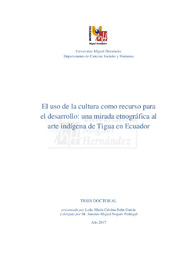Please use this identifier to cite or link to this item:
https://hdl.handle.net/11000/4493Full metadata record
| DC Field | Value | Language |
|---|---|---|
| dc.contributor.advisor | Nogués Pedregal, Antonio Miguel | - |
| dc.contributor.author | Soler García, María Cristina | - |
| dc.contributor.other | Departamentos de la UMH::Ciencias Sociales y Humanas | es |
| dc.date.accessioned | 2018-02-05T12:32:49Z | - |
| dc.date.available | 2018-02-05T12:32:49Z | - |
| dc.date.created | 2017-09-15 | - |
| dc.date.issued | 2018-02-05 | - |
| dc.identifier.ismn | 546 | - |
| dc.identifier.uri | http://hdl.handle.net/11000/4493 | - |
| dc.description.abstract | This doctoral thesis is an ethnography on the relationships among the ideas Culture, Heritage and Development in Ecuador. The ethnographic study analyses how these relationships materialize and are staged through the patrimonialisation and use of cultural elements (iconographies) of the aboriginal peoples of Ecuador as the way to innovate the contemporary artisan sector in a development project. Conceptualising Heritage as a social field — in Pierre Bourdieu’s sense — the interests and positions of national agents (public institutions, nongovernmental entities and ethnic groups) and international actors (international cooperation agencies) are studied. The analysis unveils how the ideas Culture and Heritage are conceptualised in relation with the idea Development, as well as it explains the artificiality of the patrimonial creation process. This perspective allows to understand the cultural practices of appropriation carried out by the social agents, specifically those related to the group of indigenous artists from the Tigua area, in the central region of Ecuador. These artists are worldwide known for their paintings and other handicrafts currently produced for the international market. The analysis of the social practices of use, re-signification and legitimation of these heritage elements carried out by these indigenous artists illustrates how the construction of the idea Authenticity is produced and how the tourist market is not only present, but also becomes a mediator in the production of meanings that lead to the idea Identity. Finally, the ethnographic descriptions of these practices of appropriation lead us to the aim of this thesis: the study of the processes of construction of meaning that guarantee the continuity between the representations of the memory of a group through the patrimonial resource and their present and future aspirations. Bourdieu’s concept of field applied to Heritage clarifies the network of relationships around heritage production and management, and shows how the cultural –in Appadurai’s sense—is used as a resource during the existing symbolic disputes over the type of society, the vision of the World and our self-identities. | es |
| dc.format | application/pdf | es |
| dc.format.extent | 329 | es |
| dc.language.iso | spa | es |
| dc.rights | info:eu-repo/semantics/openAccess | es |
| dc.subject | Antropología social | es |
| dc.subject | Etnografía | es |
| dc.subject | Arte indígena | es |
| dc.subject.other | CDU::3 - Ciencias sociales | es |
| dc.subject.other | CDU::3 - Ciencias sociales::39 - Etnología. Etnografía. | es |
| dc.title | El uso de la cultura como recurso para el desarrollo: una mirada etnográfica al arte indígena de Tigua en Ecuador | es |
| dc.type | info:eu-repo/semantics/doctoralThesis | es |

View/Open:
TD Soler García, María Cristina.pdf
8,36 MB
Adobe PDF
Share:
.png)
